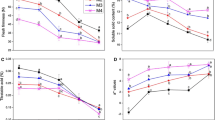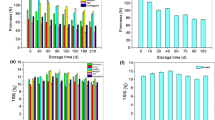Abstract
The effects of high-temperature, short-time hot air treatment (45 °C for 3 h) on soluble sugar metabolism and chilling tolerance in loquat fruit stored at 5 °C for 5 weeks were investigated. Heat treatment significantly reduced chilling severity, as evidenced by lower firmness and internal browning and higher levels of extractable juice. Meanwhile, this treatment accelerated the activities of acid invertase, neutral invertase, sucrose phosphate synthase and sucrose synthase during storage. However, sucrose degradation was predominant, which caused lower levels of sucrose and higher levels of glucose and fructose in the heat-treated group. In addition, the ascorbate acid content and the activities of ascorbate peroxidase and glutathione reductase in the heat-treated fruit were much higher than those in control fruit, resulting in lower levels of hydrogen peroxide (H2O2) and malondialdehyde and decreased membrane permeability as well as a higher unsaturated/saturated fatty acid ratio at the end of storage. Our results suggest that the increased levels of reducing sugars, especially those of glucose, may induce the ascorbate–glutathione cycle activity to scavenge for H2O2, whose content relates to the heat-induced chilling tolerance of loquat fruit.




Similar content being viewed by others
Abbreviations
- CI:
-
Chilling injury
- IB:
-
Internal browning
- H2O2 :
-
Hydrogen peroxide
- SAI:
-
Soluble acid invertase
- NI:
-
Neutral invertase
- SS:
-
Sucrose synthase
- SPS:
-
Sucrose–phosphate synthase
- AsA:
-
Ascorbate acid
- APX:
-
Ascorbate peroxidase
- GSH:
-
Reduced glutathione
- GR:
-
Glutathione reductase
- FW:
-
Fresh weight
References
Bassal, M., & El-Hamahmy, M. (2011). Hot water dip and preconditioning treatments to reduce chilling injury and maintain postharvest quality of Navel and Valencia oranges during cold quarantine. Postharvest Biology and Technology, 60, 186–191.
Cai, C., Chen, K. S., Xu, W. P., Zhang, W. S., Li, X., & Ferguson, I. (2006). Effect of 1-MCP on postharvest quality of loquat fruit. Postharvest Biology and Technology, 40, 155–162.
Cai, Y., Cao, S., Yang, Z., & Zheng, Y. (2011). MeJA regulates enzymes involved in ascorbic acid and glutathione metabolism and improves chilling tolerance in loquat fruit. Postharvest Biology and Technology, 59, 324–326.
Cao, S., Zheng, Y., Wang, K., Jin, P., & Rui, H. (2009a). Methyl jasmonate reduces chilling injury and enhances antioxidant enzyme activity in postharvest loquat fruit. Food Chemistry, 115, 1458–1463.
Cao, S., Zheng, Y., Wang, K., Rui, H., & Tang, S. (2009b). Effect of 1-methylcyclopropene treatment on chilling injury, fatty acid and cell wall polysaccharide composition in loquat fruit. Journal of Agricultural and Food Chemistry, 57, 8439–8443.
Cao, S., Zheng, Y., Wang, K., Rui, H., & Tang, S. (2010). Effect of methyl jasmonate on cell wall modification of loquat fruit in relation to chilling injury after harvest. Food Chemistry, 118, 641–647.
Cao, S., Yang, Z., Cai, Y., & Zheng, Y. (2011). Fatty acid composition and antioxidant system in relation to susceptibility of loquat fruit to chilling injury. Food Chemistry, 127, 1777–1783.
Couée, I., Sulmon, C., Gouesbet, G., & Amrani, A. E. (2006). Involvement of soluble sugars in reactive oxygen species balance and responses to oxidative stress in plants. Journal of Experimental Botany, 57, 449–459.
de Carvalho, M. H. C. (2008). Drought stress and reactive oxygen species production, scavenging and signaling. Plant Signaling & Behavior, 3, 156–165.
den Ende, W. V., & Valluru, R. (2009). Sucrose, sucrosyl oligosaccharides, and oxidative stress: scavenging and salvaging? Journal of Experimental Botany, 60, 9–18.
Ding, C., Chachin, K., Ueda, Y., Ueda, Y., & Imahori, Y. (1998). Effects of storage temperatures on physiology and quality of loquat fruit. Postharvest Biology and Technology, 14, 309–315.
Holland, N., Sala, J. M., Menezes, H. C., & Lafuente, M. T. (1999). Carbohydrate content and metabolism as related to maturity and chilling sensitivity of cv. fortune mandarins. Journal of Agricultural and Food Chemistry, 47, 2513–2518.
Holland, N., Menezes, H. C., & Lafuente, M. T. (2002). Carbohydrates as related to the heat-induced chilling tolerance and respiratory rate of ‘Fortune’ mandarin fruit harvested at different maturity stages. Postharvest Biology and Technology, 25, 181–191.
Itai, A., & Tanahashi, T. (2008). Inhibition of sucrose loss during cold storage in Japanese pear (Pyrus pyrifolia Nakai) by 1-MCP. Postharvest Biology and Technology, 48, 355–363.
Janská, A., Maršík, P., Zelenková, S., & Ovesná, J. (2010). Cold stress and acclimation—what is important for metabolic adjustment? Plant Biology, 12, 395–405.
Kafkas, E., Koşar, M., Türemiş, N., & Başer, K. H. C. (2006). Analysis of sugars, organic acids and vitamin C contents of blackberry genotypes from Turkey. Food Chemistry, 97, 732–736.
Khademi, O., Salvador, A., Zamani, Z., & Besada, C. (2012). Effects of hot water treatments on antioxidant enzymatic system in reducing flesh browning of persimmon. Food Bioprocess Technology. doi:10.1007/s11947-012-0959-6.
Klein, J. D., & Lurie, S. (1992). Prestorage heating of apple fruit for enhanced postharvest quality: interaction of time and temperature. HortScience, 27, 326–328.
Lara, M. V., Borsani, J., Budde, C. O., Lauxmann, M. A., Lombardo, V. A., Murray, R., et al. (2009). Biochemical and proteomic analysis of ‘Dixiland’ peach fruit (Prunus persica) upon heat treatment. Journal of Experimental Botany, 60, 4315–4333.
Li, J. (2000). Determination of the content of reduction type VC with phosphomolybdate blue spectrophotometry. Food Science, 21, 42–45.
Li, W., Shao, Y., Chen, W., & Jia, W. (2011). The effects of harvest maturity on storage quality and sucrose-metabolizing enzymes during banana ripening. Food Bioprocess Technology, 4, 1273–1280.
Lin, S., Sharpe, R. H., & Janick, J. (1999). Loquat: botany and horticulture. Horticultural Reviews, 23, 233–276.
Ma, Y., Zhang, Y., Lu, J., & Shao, H. (2009). Roles of plant soluble sugars and their responses to plant cold stress. African Journal of Biotechnology, 8, 2004–2010.
Mao, L., Que, F., & Wang, G. (2006). Sugar metabolism and involvement of enzymes in sugarcane (Saccharum officinarum L.) stems during storage. Food Chemistry, 98, 338–342.
Miller, G. L. (1959). Use of dinitro salicylic acid reagent for determination of reducing sugar. Annals of Chemistry, 31, 426–428.
Miron, D., & Schaffer, A. A. (1991). Sucrose phosphate synthase, sucrose synthase and invertase activities in developing fruit of Lycopersicon esculentum Mill. and the sucrose accumulating Lycopersicon hirsutum Humb. and Bonpl. Plant Physiology, 95, 623–627.
Nishikawa, F., Kato, M., Hyodo, H., Ikoma, Y., Sugiura, M., & Yano, M. (2003). Ascorbate metabolism in harvested broccoli. Journal of Experimental Botany, 54, 2439–2448.
Nishikawa, F., Kato, M., Hyodo, H., Ikoma, Y., Sugiura, M., & Masamichi, Y. (2005). Effect of sucrose on ascorbate level and expression of genes involved in the ascorbate biosynthesis and recycling pathway in harvested broccoli florets. Journal of Experimental Botany, 56, 65–72.
Noctor, G., & Foyer, C. (1998). Ascorbate and glutathione: keeping active oxygen species under control. Annual Review of Plant Physiology and Plant Molecular Biology, 49, 249–279.
Purvis, A. C., & Grierson, W. (1982). Accumulation of reducing sugar and resistance of grapefruit peel to chilling injury as related to winter temperatures. Journal of Agricultural and Food Chemistry, 107, 139–142.
Quan, L., Zhang, B., Shi, W., & Li, H. (2008). Hydrogen peroxide in plants: a versatile molecule of the reactive oxygen species network. Journal of Integrative Plant Biology, 50, 2–18.
Rui, H., Cao, S., Shang, H., Jin, P., Wang, K., & Zheng, Y. (2010). Effects of heat treatment on internal browning and membrane fatty acid in loquat fruit in response to chilling stress. Journal of the Science of Food and Agriculture, 90, 1557–1561.
Shao, X., Tu, K., Tu, S., & Tu, J. (2012). A combination of heat treatment and chitosan coating delays ripening and reduces decay in ‘Gala’ apple fruit. Journal of Food Quality, 35, 83–92.
Smirnoff, N., Conklin, P. L., & Loewus, F. A. (2001). Biosynthesis of ascorbic acid in plants: a renaissance. Annual Review of Plant Physiology and Plant Molecular Biology, 52, 437–467.
Song, Y., Shao, X., Shi, T., & Cheng, S. (2011). Effects of short-time hot air treatment on the quality and chilling injury of loquat fruits during storage at low temperature. Journal of Fruit Science, 28, 837–842.
Tian, S., Li, B., & Ding, Z. (2007). Physiological properties and storage technologies of loquat fruit. Fresh Produce, 1, 76–81.
van Handel, E. (1963). Direct microdetermination of sucrose. Analytical Biochemistry, 22, 280–283.
Xu, H., Chen, J., & Xie, M. (2010). Effect of different light transmittance paper bags on fruit quality and antioxidant capacity in loquat. Journal of the Science of Food and Agriculture, 90, 1783–1788.
Zaharah, S. S., & Singh, Z. (2011). Postharvest nitric oxide fumigation alleviates chilling injury, delays fruit ripening and maintains quality in cold-stored ‘Kensington Pride’ mango. Postharvest Biology and Technology, 60, 202–210.
Acknowledgments
This study was sponsored by the National Science Foundation of China (no. 31000825), Natural Science Foundation of Zhejiang Province (no. Y3090537), International Foundation for Science (E/4412-1) and the K. C. Wong Magna Fund at Ningbo University.
Author information
Authors and Affiliations
Corresponding author
Rights and permissions
About this article
Cite this article
Shao, X., Zhu, Y., Cao, S. et al. Soluble Sugar Content and Metabolism as Related to the Heat-Induced Chilling Tolerance of Loquat Fruit During Cold Storage. Food Bioprocess Technol 6, 3490–3498 (2013). https://doi.org/10.1007/s11947-012-1011-6
Received:
Accepted:
Published:
Issue Date:
DOI: https://doi.org/10.1007/s11947-012-1011-6




